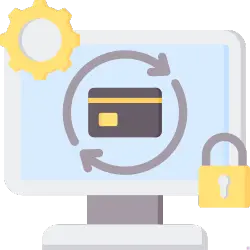
TABLE OF CONTENTS
- What Is Payment Processing?
- How Does Payment Processing Work?
- 5 Payment Methods Used in Payment Processing
- Payment Processing Account Types
- Payment Processing Fees & Pricing Models
- Why Payment Processing Is Important for Every Business
- What to Consider When Choosing a Payment Processor
- Tips and Best Practices for Effective Payment Processing
- Closing Thoughts
- Payment Processing FAQs
At its core, payment processing involves executing financial transactions between a customer and a business. It enables various payment methods, ensuring security and ultimately facilitating the exchange of money for goods and services. So, what is payment processing? As a business owner, you might have heard the term but don’t necessarily understand its meaning. Here’s information about the process step-by-step, from payment initiation to settlement. We explain the role payment processors and payment gateways play in this ecosystem along with offering tips and best practices.
What Is Payment Processing?

Payment processing is a sequence of actions facilitating secure fund transfers between a payer and a payee. It encompasses the acceptance of both physical and digital payments. This process involves multiple tools and technologies, extending beyond credit cards to checks, mobile payments, and digital currencies. While credit and debit cards remain the dominant payment method, options like contactless, mobile, and online payments are gaining prominence.
A payment processing system handles various transaction types, such as credit cards, debit cards, electronic funds transfers (EFT), automated clearing house (ACH) transfers, digital wallets, mobile payments, and cryptocurrencies. Various stakeholders, such as banks, payment processors, technology providers, and regulatory bodies, collaborate to manage these systems.
How Does Payment Processing Work?
Payment processing involves a series of actions to facilitate the secure funds transfer between a payer and a payee. Here’s a detailed overview of how payment processing works:
- Payment Initiation—The process starts when a customer initiates a payment. They do this by providing payment details or authorizing a transaction, such as swiping a card, making an online purchase, or initiating a digital payment.
- Authorization—The transaction data is transmitted to the payment processor or gateway following payment initiation. The payment processor conducts a thorough validation process, checking for fraud, available funds, and other factors. Upon successful authorization, the funds are reserved in the payer’s account to cover the impending payment.
- Transaction Routing—The transaction data is routed to the appropriate financial institutions and networks, including the payer’s bank, the payee’s bank, and card networks.
- Verification — The receiving financial institution verifies the transaction details and assesses the payer’s account for adequate funds.
- Settlement—Once verification is complete, the payment is considered settled. Funds are then transferred from the payer’s account to the payee’s. Depending on the chosen payment method and system, settlement may occur in real time or be batched and processed at the end of the business day.

What Role Does a Payment Processor Play?
A payment processing system is an intermediary in financial transactions, orchestrating funds transfer between payers and payees. It basically oversees the end-to-end management of transactions, from authorization to settlement. Payment processors also play a role in the secure transfer of funds, oversee payment gateway services for online transactions, and provide businesses with transaction records and financial management reports. Their connections to financial networks ensure the smooth flow of transaction data, contributing to the efficiency of the financial ecosystem.

Payment Processor vs Payment Gateway
A payment processor is responsible for distributing transaction data to the relevant locations in the payment chain. This includes routing data to the customer, your business, the receiving bank, and the acquiring bank. Payment processors are integral in setting up merchant accounts that enable your business to accept credit card payments. They aren’t only important for online transactions. They also provide your business with point-of-sale terminals, extending their services to in-person transactions.
On the other hand, a payment gateway primarily acts as the bridge between the customer and your business during a transaction. It manages the process of accepting or declining payments, ensuring secure data transmission and authentication. Payment gateways integrate into your business’s online store or accounting software, allowing you to process credit cards from existing systems without requiring additional solutions. Their main function is to handle online payment transactions and provide a seamless checkout experience for customers.
5 Payment Methods Used in Payment Processing
There is a diverse array of payment methods catering to varying consumer and business preferences. These five methods, from credit and debit cards to digital currencies, are integral to modern payment processing.

Credit and Debit Cards
Credit and debit cards are the most popular payment methods worldwide, offering convenience and security. Customers use them when paying for purchases by swiping or inserting their physical cards at point-of-sale terminals. They can also enter card details for online transactions. Credit card transactions are typically processed through a payment gateway before routing to the merchant account for settlement, making them the predominant choice for eCommerce businesses.

Online Payments
Online payments encompass a range of digital methods, including bank transfers, digital wallets, and electronic funds transfers. They enable customers to make online secure payments, often using computers or mobile devices. Online payments are versatile and cater to a wide variety of online businesses.

Mobile Payments
Mobile payments, including most mobile point-of-sale (mPOS) transactions, are primarily processed with credit cards. They can be facilitated through various means, such as payment apps, chips, contactless methods, or mobile device-connected swipers. These transactions follow a process similar to online payments. The payment routes to your payment processing system for verification and settlement. Then, it results in the funds being credited to your business bank account, with applicable fees deducted. Mobile payments are gaining popularity due to their speed and ease of use, making them suitable for both in-store and online purchases.

ACH and eCheck
ACH, or Automated Clearing House, simplifies electronic fund transfers between bank accounts, commonly used for transactions directly through checking accounts, particularly for larger B2B payments. eChecks offer an appealing alternative for merchants, featuring fewer underwriting guidelines, swift setup, and generous transaction limits compared to credit cards, making them ideal for regular receipt of substantial payments, such as wholesale B2B suppliers. Merchants seeking to accept eCheck payments should collaborate with an expert merchant processor. Both ACH and eCheck payments are cost-effective, reducing reliance on paper checks, and are suitable for recurring payments.

Cryptocurrencies
Cryptocurrencies like Bitcoin and Ethereum, known for their security through cryptography, have gained popularity for online transactions. Businesses can now accept cryptocurrencies, as payment gateways employ blockchain technology to process these payments and convert tokens into stablecoins pegged to the dollar.
Payment Processing Account Types
Payment processing account types encompass a range of options, each one tailored to different needs and preferences.

Merchant Account
A merchant account is a financial tool businesses use to accept non-cash payments, allowing them to receive funds from credit card transactions directly. Some business owners may already possess a merchant account if they’ve previously accepted credit cards. However, it’s not automatically included with registration or incorporation paperwork. To obtain a merchant account, businesses often undergo background and credit checks. They need to partner with an acquiring bank to establish a financial vehicle that provides them with control over their payment processing.

Payment Service Provider
Payment service providers (PSPs) offer a streamlined, all-in-one solution for businesses to process payments. These providers take care of various payment processing aspects, including payment gateway services and transaction settlement, catering to businesses seeking hassle-free payment processing. PSPs link your bank to your customer’s bank and the credit card networks. This makes it possible for businesses to accept various payment methods, including debit and credit card payments. Popular examples of PSPs include Square, Paypal, Skrill, and Stripe.

Merchant Account vs PSP
A merchant account is a dedicated financial tool for accepting payments. It allows direct receipt of credit and debit card payments, often established through acquiring bank partnerships. In contrast, PSPs offer businesses an all-in-one payment processing solution. Merchant accounts provide more control and cost-saving potential but involve greater administrative effort, while PSPs offer simplicity and convenience, albeit potentially with higher fees. Careful consideration of these distinctions is essential when choosing a payment processing account type.
Payment Processing Fees & Pricing Models
Understanding the intricacies of a payment processing system’s fees and pricing models is crucial for businesses to manage their financial operations effectively. They are:

Interchange Fees
Interchange fees represent a fundamental component of payment processing costs. These fees are set by credit card networks such as Visa, Mastercard, and Discover, as well as issuing banks. They are non-negotiable and vary based on various factors, including the type of card used (e.g., credit or debit) and the risk level associated with the transaction. They often constitute a significant portion of a business’s payment processing expenses. As these fees are largely beyond a business’s control, it’s essential to be aware of their impact and plan accordingly.

Assessment Fees
Assessment fees are another non-negotiable cost associated with payment processing. Credit card networks establish these fees as fixed percentages of the transaction’s total value. Assessment fees support the maintenance and security of the card networks. These fees are inherent in the payment processing ecosystem and are necessary for facilitating electronic transactions.

Payment Processor Fees
Payment processors are the intermediaries in the payment processing chain. These service providers charge businesses for their services, and the fees can vary widely among different providers. To effectively manage payment processing costs, businesses must comprehend the pricing structures payment processors use. Common pricing models include flat-rate pricing, subscription-based pricing, and tiered pricing. Each model has distinct advantages and disadvantages, impacting how much a business pays for payment processing services.

Additional Fees
Beyond the core components of payment processing fees, businesses may encounter a range of additional charges. These include chargeback fees, monthly statement fees, and PCI compliance fees, among others. These additional fees can significantly influence a business’s overall payment processing expenses.

Pricing Models
Payment processing pricing models vary, with three main types: flat-rate pricing, membership/subscription-based pricing, and tiered pricing.
With flat-rate pricing, businesses pay a fixed fee for each transaction, irrespective of factors like the type of card used or interchange rates. This model is particularly attractive to small businesses and startups due to its predictability and ease of management. However, while it simplifies fee forecasting, it may not be the most cost-effective choice for businesses with high transaction volumes or those dealing with premium cards.
Membership/subscription-based pricing involves a monthly or annual fee in addition to the interchange rate charged by the card network. It offers predictability in monthly costs and access to various processing features, making it suitable for businesses with consistent transaction volumes. Large, established businesses can benefit from potential cost savings under this model. Yet, it’s essential to carefully scrutinize the transaction fees, as they may be higher under subscription models.
Tiered pricing categorizes transactions into different tiers based on factors like card type and processing method. Each tier has its corresponding fee structure, which allows for pricing flexibility. Businesses can benefit from lower fees for standard transactions, but the model introduces complexity. Transactions are classified into Qualified, Mid-Qualified, and Non-Qualified rates, and some may fall into higher-cost tiers.
Why Payment Processing Is Important for Every Business
In today’s age, an efficient payment processor is critical for the success of any business. These systems streamline financial transactions and provide customer convenience and swift transaction processing that can lead to improved cash flow management. By offering various payment methods and reducing waiting times, businesses enhance customer experience and operational efficiency. Additionally, the security measures in modern payment processing systems protect against fraud, build trust, and safeguard business reputations. A payment processing system can also offer valuable insights through analytics, helping data-driven decision-making.
With the evolving payment processing landscape, businesses that adopt new technologies can gain a competitive edge, ensuring their adaptability to trends and compliance with industry standards. Efficient payment processing is a strategic investment that drives customer satisfaction, operational efficiency, and long-term business growth.
What to Consider When Choosing a Payment Processor
When selecting a payment processor for your business, consider these factors.

Industry-specific support
Evaluate whether the payment processor caters to your industry’s specific needs. Look for features or tools tailored to your business sector, ensuring seamless integration and optimal functionality. Additionally, be aware of industry-specific restrictions, as some payment processors may limit services based on regulatory or financial risk associated with certain business types. Industries with high rates of fraudulent transactions and chargebacks or those regulated under federal or state law may encounter limitations in payment processor choices.

Integration Compatibility
Assessing the integration process is crucial for operational efficiency. Evaluate how well the payment processing solution integrates with your website, e-commerce platform, or POS system. Additionally, check for compatibility with various devices and operating systems to accommodate customer preferences. If your processor doesn’t support online payments, consider opting for a single, versatile processor to streamline transactions.

Security and Compliance
Prioritize a payment processing system emphasizing security measures and industry standards compliance. Look for features such as encryption, tokenization, and adherence to relevant regulations to protect sensitive customer information. Security is a paramount concern for business owners in payment processing, considering the potential risks associated with data breaches of cash transactions. Assess security features such as encryption through chip card technology (EVM), which significantly reduces the risk of counterfeiting. Additionally, check for PCI compliance, ensuring that your payment processor alleviates the burden of PCI compliance.

Customer support
Reliable customer support is a must to address issues that may arise in payment processing. Look for customer support channels, response times, and the overall reputation of the payment processor in efficiently providing assistance. Customers appreciate effective customer service in instances of unexpected fees, missing deposits, or technical issues with hardware. Prioritize processors with positive reviews, reaching out to trusted merchants for recommendations.

Transparent pricing
Transparent pricing is another consideration when selecting a payment processor. It involves understanding all fees. Look for a processor that provides a clear breakdown of costs to avoid hidden costs. Further, make sure it also aligns with your budget. This transparency fosters trust and facilitates effective financial planning for your business.
Tips and Best Practices for Effective Payment Processing
To ensure effective payment processing, consider the following best practices:
- Stay Informed on Industry Standards — Regularly update yourself on industry standards and regulations to ensure compliance and security in payment processing methods.
- Prioritize Security Measures — Implement robust security measures, including encryption and tokenization, to protect against potential data breaches.
- Offer Diverse Payment Options — Provide various payment methods such as credit cards, debit cards, digital wallets, and emerging technologies to accommodate customer preferences.
- Streamline the Checkout Process — Optimize your checkout process for simplicity and efficiency.
- Invest in Mobile Payment Solutions — Prioritize mobile payment solutions for customers who prefer smartphone transactions.
- Regularly Review and Update Systems — Conduct periodic reviews of your payment processing system. This will ensure the hardware and software are up-to-date with the latest security enhancements.
- Utilize Data Analytics—Leverage data analytics to gain insights into customer behavior, purchasing patterns, and market trends.
- Understand and Negotiate Fees — Understand all fees associated with your payment processor, negotiate where possible, and choose a provider with transparent pricing.
- Educate Staff and Customers —To foster trust, educate your staff on secure payment practices and inform customers about your security measures.
- Ensure PCI Compliance — Adhere to PCI DSS requirements, confirming that your payment processor handles necessary compliance processes.
- Implement Chargeback Prevention Strategies — Develop effective strategies to prevent and manage chargebacks. Communicate clearly with customers.
Closing Thoughts

Navigating payment processing fees directly impacts overall costs. You should understand the intricate process and roles of key players like payment processors and various account types, from merchant accounts to payment service providers. Payment processing is the linchpin of financial transactions.
Modern systems offer security, generate insights, and ensure compliance with industry standards. When selecting a payment processor, it is crucial to consider industry-specific support, integration compatibility, security measures, customer support, and transparent pricing. At PaymentCloud, we offer all this and more. Reach out today and see what we can do for you!
Payment Processing FAQs
How long does it take to process a payment?
Credit card payment processing time varies based on factors like payment method and banking processes. In-person transactions are swiftly authorized, either instantly or through batch processing at the end of the business day. Settlement can be real-time for some transactions but may take days for others, depending on the bank. Weekends and holidays can extend processing times. Temporary holds or pending charges may occur, with the final amount determined during settlement. From authorization to settlement, the entire process can take seconds to several business days, influenced by diverse factors such as bank policies and transaction types.
Can I accept payments without a payment processor?
If you want to accept payments with any kind of card, you must have a payment processor. A payment processor handles transactions and manages tasks like authorization and compliance with industry standards. Without one, businesses face manual, error-prone processes. While you might receive funds directly, using a payment processor is highly recommended for efficiency, security, and compliance.
How secure are payment processing systems?
Payment processing systems utilize four security measures – encryption, tokenization, authentication, and fraud detection and prevention. Encryption employs symmetric and asymmetric methods such as SSL/TLS to secure data transmission. Tokenization minimizes the risk of data breaches by replacing valuable payment information with tokens. Authentication methods, including CVV, OTP, and biometric verification, verify user identity. Fraud detection and prevention systems monitor transaction patterns using machine learning and behavior analysis.
Can a payment be reversed after it is processed?
A customer’s bank can only initiate a reversal under specific circumstances, such as an incorrect transfer amount, errors in account numbers, duplicate transfers, or incorrect transfer dates. In these instances, the bank is required to reverse the charges within five days and notify the affected account owners. Notably, only the payment sender can request reversals, not the payee or biller. Additionally, payments can be reversed through processes like chargebacks or refunds. Chargebacks, initiated by customers disputing transactions, result in funds being returned to the customer after the merchant provides evidence to contest the claim. On the other hand, refunds are merchant-initiated and are often based on established refund policies, addressing reasons such as product returns or cancellations.





